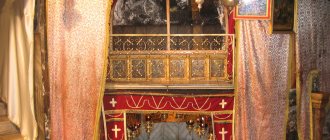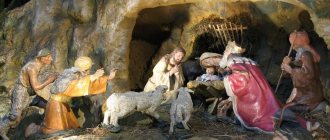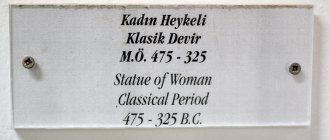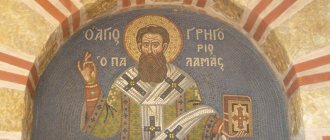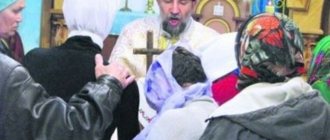The meaning of the word Nativity scene according to the Brockhaus and Efron dictionary:
Nativity scene (German Christschau, Polish Szopka, from German Schoppen - stable or barn) - this is what they call it in Little Russia, Poland, Belarus and some others. places in Siberia, performances aimed at depicting the Nativity of Christ and events associated with it. V., apparently, penetrated into our old theater from Poland, no earlier than the end of the 16th century. In the West, there have long been spiritual and theatrical rituals performed at Christmas (see Mysteries). From here it was easy for them to penetrate into Catholic Poland, and then into Little Russia. Polish szopka, which at that time (16th century) became a common recreational activity of Polish seminarians who walked around cities and villages with their miniature theater, in our south received the name “nativity scene”. This kind of spiritual and theatrical performances was very popular in Ukraine and only in the last two decades began to disappear. The seriousness of the content of the nativity scene did not prevent folk humor from penetrating into it. In the person of Herod, warriors beating infants, shepherds who came to worship Christ, and others, types of a purely local character were often embodied. A Polish or Little Russian nativity scene is a small wooden box or house with two tiers: the upper one represents the serious part of the “action” (spiritual), and the lower one represents the interlude. By the hand of a lively walker (called the nativity scene maker), hidden behind, invisibly for the audience, dolls and figures are set in motion, for which the nativity scene maker himself speaks, changing his voice according to the role. Together with V. they usually wear a “ star”
".
The prologue to the nativity scene is the singing of carols and “kantychkas” performed by the bearers of the nativity scene and the star. V. is often accompanied by a home-grown orchestra, in most cases consisting of a violin and tambourine. Ukrainian V. was studied by N. Markevich in the book “Customs, beliefs, etc. of the Little Russians” (Kyiv, 1860), where the full text of one of the nativity plays is given. After the opening choir, the sexton appears, inviting everyone to announce the birth of the Savior. The action is accompanied by a number of sacred cants, interrupted by individual phenomena, which depict: the worship of the shepherds, Herod and the three kings, the beating of the infants, the cry of Rachel and the death of Herod, whom the devil drags to hell. There is nothing to be afraid of the dead Herod, and therefore the did
and
the woman
- a comic intermezzo - dance to the sounds of the song “Oh, under the cherry tree, under the cherry tree.”
Behind the grandfather and grandmother comes a soldier, giving a speech to the audience in which he deliberately distorts the Great Russian dialect. The soldier certifies himself: “I am a simple soldier, not a theologian, I don’t know sinful words. Although I am the essence of defense for the fatherland, my back is beaten. I don’t know how to read or write, but I say what I understand,” etc. The soldier is replaced by a gypsy with his wife and son. The gypsy takes out her anger on the gypsies for their poverty. the quarrel turns into a fight. the matter ends with peace and dancing to a lively song, in which the wandering gypsy life is ridiculed. Then a Hungarian and a Pole appear on stage, each with their own characteristics. The Pole, a formidable landowner, is portrayed as a braggart, especially proud of his ancestors. Together with his wife, the Pole usually dances the Krakowiak. The scene ends with scolding at the boy for sneaking up and imitating his master. the angry landowner says: “Pudz dzembla, laidak!” I’ll kill you with batogs.” The swearing of the master falls silent when the Cossack, the main character of the play, appears. Backstage, he sings his favorite Little Russian song: “It won’t be better, it won’t be more beautiful, like here, like in Ukraine!” The well-dressed Cossack is deliberately depicted as an endangered type, sadly recalling the dashing old days: “Ay, gentleman, what was it when I was young, that’s why I had strength!” The thoughts are followed by tomfoolery over the gypsy sorceress and over the Jew, whom the Cossack hands over to the devil. The Cossack treats the devil as an equal, and this again shows his courage: he even urges the devil with his mace to quickly remove the Jew. The oppression of the union is not forgotten here either. The Cossack boldly responds to the admonitions of the Uniate priest to go to church and bow more: “I never went to church and never bowed, but I will beat you!” Finally, in the person of the sexton, who speaks a semi-ecclesiastical language incomprehensible to the common people, seminary learning is ridiculed. The peasant Klim gives the clerk, in exchange for money for his son’s apprenticeship, a pig, old and lascivious, which no one buys. the clerk, confident that he has deceived the man, accepts her with pompous gratitude. A comparison of the text of the spiritual scenes of the Little Russian nativity scene with the corresponding Polish and German texts makes it probable that the Little Russian nativity scene was composed by students of the Kyiv Academy in later times and not earlier than the beginning of the 18th century. The Polish influence affected only the general structure of the play, but the details were worked out independently. The reflection of real life in nativity plays is the main reason for the speed with which nativity scenes spread across the whole of Russia. In Belarus, the nativity scene appeared in the 1830s. here it is often called betleika
(from Betleem - Bethlehem).
Mr. Kulzhinsky, who saw and described the Belarusian betleika (“Betleiki in the North-Western Territory,” in “Soulful Reading,” 1873, vol. III) says that the betleika “is completely uncensored and has almost nothing to do with the Nativity of Christ. “It is especially strange to mix sacred images with clownish ones, and yet the betleika is popular here and loved by the common people.” Settlers or exiles probably brought the nativity scene to Siberia, where the puppets are called lords and heroes. Eyewitnesses of Siberian nativity scenes describe their structure as similar to the Little Russian nativity scene. N. Polevoy in the “Repertoire” for 1840 (in the article “History of the Russian Theater. My Memoirs”) describes the nativity scene he saw in Irkutsk in the first years of this century. The play of horn players and violinists accompanies the performance (cf. Snegirev, “Russian Common Holidays”). In northeastern Russia, a special kind of nativity scene was created under the new name raika
, which probably originated from the ideas in nativity plays about
heaven
and
torment
. It must be assumed that the puppet theater was also brought to Moscow from the south. but here the character of the district is influenced by those introduced from the end of the 17th century. from the West of amusements, on the one hand, and the development of popular prints, on the other, it changes, and from a puppet theater, Paradise turns into a folk panorama: glass is inserted into the nativity scene, puppets are replaced by paintings, and the nativity scene’s owner’s sayings are replaced by the speech of the nativity scene. In addition to the above works, cf. Konopka, “Piesni lu du krakowskiego” (1840, 85-90). Jos. Sikorski, “Jaseł.ka” (in the magazine “Pamię.tnik muzyczny i teatralny”, 1862, nos. 2 -15). Kolberg, "Lud" (V, 197-226). “Ethnographic collection” (I, 320 - 322). Shchukin, “Nativity scene” (“Bulletin of the Imperial Russian Geographical Society,” 1860, VIII, 25 -35). Galagan, “Little Russian Den” (with a preface by Zhitetsky, in “Kyiv Antiquity” 1882, book 10, with drawing and notes). O.P., “An outgoing or initial form of nativity play drama?” (ibid., 1883, No. 4). "On the issue of nativity comedy in Ukraine." (ibid., no. 12). Bessonov, “Belarusian songs” (98-99, 104-105). Alexey Veselovsky, “Ancient Theater in Europe” (Moscow, 1870). P. Morozov, “Essays on the history of Russian drama of the 17th - 18th centuries” (St. Petersburg, 1888).
How does the action take place?
The nativity scene is based on a story telling about the coming of the Savior to earth. An angel announces the birth of God. The Shepherd and three Magi come to worship the newborn Baby, telling about their meeting with Herod, to whom they informed about the birth of the future great King. An angel warns the Magi not to “go to Herod” (he is afraid that the born King will take away his power). An angry Herod commands the Warrior to “beat the babies” in Bethlehem. Rachel comes to Herod, begging him not to kill her child: A voice is heard in Rama, weeping and sobbing, and a great cry; Rachel cries for her children and does not want to be consoled, for they are not there (Jeremiah 31:15 , Matthew 2:18 ). An angel consoles Rachel. Death comes to Herod, he asks her for a reprieve, but Death calls the Devil, and he drags Herod into the underworld.
In the second part of the performance, everyday scenes are shown, then the characters “say goodbye” to the audience.
As Goldovsky writes, the music in both acts of the performance was no less important than the text. She always gave very accurate characterizations to the characters and filled the performance itself with celebration. Particularly popular were cants, which combined folk songs and secular dance melodies.
Rachel. Nativity scene of V. Novatsky
The role of the Nativity scene in Christian parenting
A child raised in an Orthodox family has knowledge of God and knows what a Nativity scene is. And when he comes to church with his parents or godparents on holidays and listens to the chapter from the Gospel about the birth of Christ, a magical nativity scene appears before his eyes.
His story seems to come to life in a child’s mind. And household members who decide to arrange a nativity scene at home will act very wisely. The symbolism of the two-tier cave is unchanged: heaven is located above, hell below. The Jesus family figurines are on the top tier on the left side.
On raising children in faith:
- How to instill in a child the love of God
- Conversations with children about the pectoral cross
- How to teach children prayer
Let the child make his childish contribution, thereby he will feel with his pure soul the approach of Christmas, the Savior’s love for every person on earth, especially for children.
A great way to spend your time will be reading good Christmas tales and stories at your home nativity scene. It would be good if there was an opportunity to animate the action being read.
Christmas nativity scene. Church of St. Martin the Confessor in Alekseevskaya Sloboda
Scenarios
Usually school theater groups, church parishioners and theater artists stage performances, acting out the events of Christmas night. This is a way to touch a miracle!
A nativity scene is placed on the stage, a manger, figurines of the Blessed Virgin Mary, and Her husband Joseph are placed in it. Nearby are figures of animals that warmed the newborn God-infant with their breath. Figures of shepherds and wise men who came to Him with Gifts are also placed here.
The top of the nativity scene is crowned with the Star of Bethlehem - a symbol of the birth of the Savior.
More about entertainment for children:
- Orthodox films for children
- Orthodox cartoons for children
